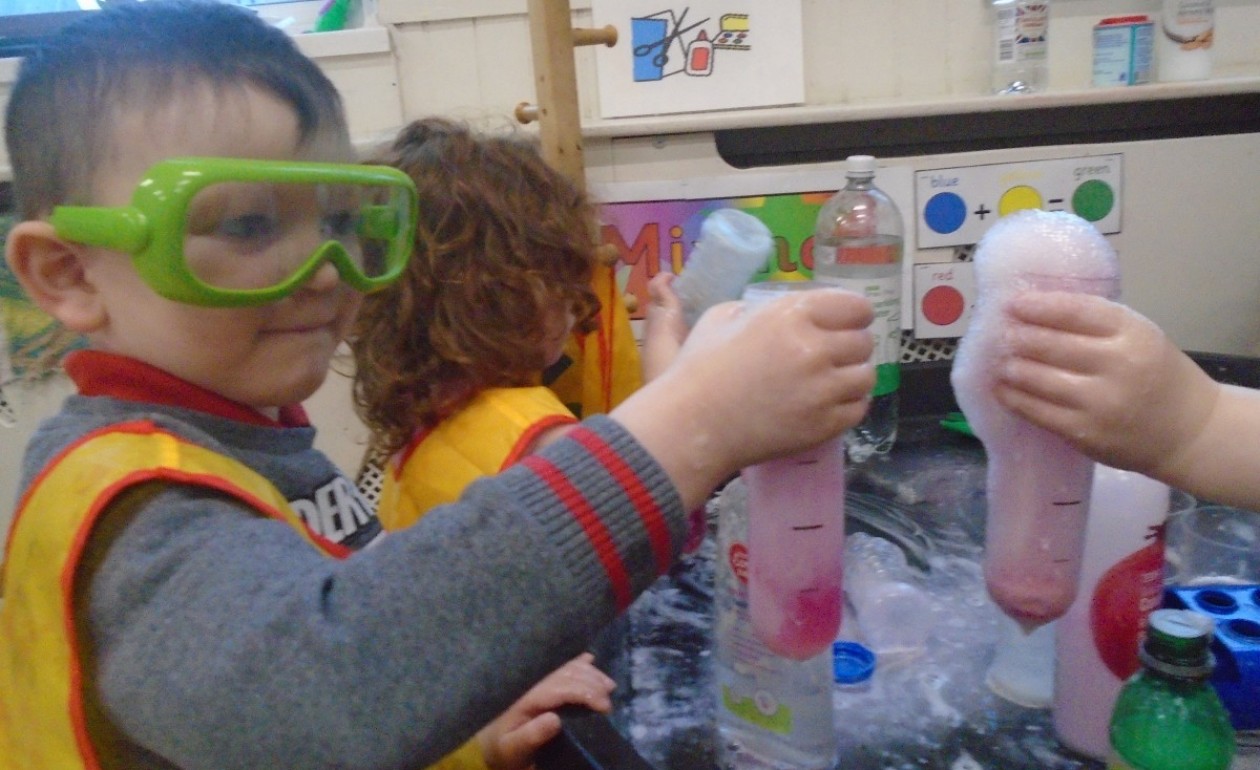You may have heard and seen onTwitter that the children in the main building have been learning about space recently. Some of this has been by watching clips of Commander Chris Hadfield in the International Space Station
During these clips we have looked at the effect of being away from most of Earth’s gravity, and how this effects daily routines such as washing etc. So we know that little gravity means things float but what does gravity mean on Earth, where it is stronger, and why is it stronger on Earth?
We set out to explore gravity. We started by experimenting to see if all objects are effected the same way – does everything fall? Do some things fall faster/ slower?
We chose our objects and made predictions:


Patrick discovered that it had to be a fair test and that the objects needed to start from the same height and at the same time. His experiment had to be redone twice over to ensure a fair test!


We tested our hypothesis.



But why don’t you have a look at the predictions and experiments themselves! Look at Holly’s prediction and Ryan’s prediction.
Have a look at Lauren’s experiment, Holly’s experiment, Gaby’s experiment, Amy D’s experiment and the experiments of Finn, Brandon, and An, who goes at 2!
So what happened?
Maybe we should ask for Ryan’s conclusions, Lyall’s gravity explanation or Isla’s conclusion.
“they all fall at the same time ’cause of gravity!” Eve
We reviewed our predictions:


Then we looked at hankies – two hankies the same should land at the same time – just as everything else right? Wrong! If one was scrunched up and the other flat, the air resistance made a difference, slowing the flat one.
 So everything fell at the same speed unless the air drag slowed it down. The air drag acts as an opposing force.
So everything fell at the same speed unless the air drag slowed it down. The air drag acts as an opposing force.
Hmmmm…………. what else could make an opposing force to gravity?
Want to find out more about gravity? Have a look here or here.
Why not try your own experiments and let us know how you get on!








!["They will go red"[the liquids] "Carbonated water first, vinegar last"](https://glow-prod-in.s3.eu-west-1.amazonaws.com/in/public/kellystscientists/uploads/sites/4816/2016/01/DSC04649-e1454081233148-197x300.jpg?X-Amz-Content-Sha256=UNSIGNED-PAYLOAD&X-Amz-Security-Token=IQoJb3JpZ2luX2VjEOT%2F%2F%2F%2F%2F%2F%2F%2F%2F%2FwEaCWV1LXdlc3QtMSJGMEQCIAxWGIfhXYB92uHhrf5dqG4EJTwenlPeOihhOx7FWgH5AiAJMUlz7agb%2Bs3vFMdja2E4JSCKMOJEV1n8tbeHMs2QxyrBBQiN%2F%2F%2F%2F%2F%2F%2F%2F%2F%2F8BEAUaDDI3MzU3MDE5NTQzMyIMACKjYsnptEY%2BVrvrKpUFgx5Kuh67JJ%2B7%2BAjReVB3MXyieDSy3jS0t4jLULd8cbpySd2Nda0JdFd1yXP0ijwPxsiIjvUhKSpydrnUGqjxtCHWZc0CpkT24pJKONQT36xFeHMw3uLJZ1EctxJEGw0hRkt46sJw1M2KosWAGd1WItF%2FBkrufuRy%2BvoK6W4didhY1KDeR2MT4o5%2F9RjnH2TlZ3GXmskg0W0kjGEtk4imCFgn%2BpiMGREmpbdmoewTayWeqMpMqN7WqrcJEnhyOhd%2BZ6Te3xIBDQGhyUTaPmgV4baUv7HdqQRNX87r4MT8VAItKp4WAqbYuQIg7mOJ%2FBKWCwb8T2FXijdxwFg0qo0%2FIm%2BIgqVlggfQ4rlU%2F3uKKHFgI9Xg0fFkdaRMKXsTQT7ApS%2FouG%2B%2FNcebhf2ZPggyFGjCDRu2JWz99YInMos%2BgrACTL01yl0YAtPvGXwFdeIwkcOtpNSE2V4kEIZbzAj99MAuLqWSRi2fV67UIc31s6OllzYJ9%2B%2FIj2VLSYFhOJ51L6OvknE%2Bug2txL3uUFCVB3pEbCepFWc8mysv0CKevB%2B8dYL3PNcICos6bA%2BrJz7Kua%2FxZgkramo7VfAwu%2B7K4TUUakkDpARSae6OhmmFyKG%2B2BJd%2Fqv6%2Frds8331AkjC60ERHcacBNcYxg0OTzyx4W80sayKmNnecOEY%2Be5P90FS0eAjesg1NQn80FgNXctBJaFDLO9E3yXOf1IhcY1CVG67Eu3SUOxykG5BMfihqeuGfeyUDXX1MfbNkmNtzAJcEAB9SzSG2llUMTKM34NzpZBDVPwKoVovniFfFhJP7QmmH74FVAJ3y%2BsHcGfUyG4fekaDYZpFjxiJ%2FlcPbaU7pY2Oyi6WoQh6H7N5MM4zkRLI5ok6EDDX96u6BjqyAXgUuyNPEU262aqNYr2cRRCMKofbE1wMxgEs%2FjCXdJI%2F2UAW3Oxnfdxo0UInW5dDD6OtN1RorNBT76hdPjdwrbiqUfqsriQyAPvy%2BVzSVDioDVRQE%2BGgBAdnz8JL4De4bdCZqZ9bHy0CehvL%2BOHK51JCQfHQd%2BhHhcm3sLcgX1Vbw3bJA0ozhudXVVPVXfUXwSVM3KXovAGhRIZhwWv%2Bz473EJJoXA1jyfmVCKZb5aydDPk%3D&X-Amz-Algorithm=AWS4-HMAC-SHA256&X-Amz-Credential=ASIAT7MQN47URAELYM3O%2F20241130%2Feu-west-1%2Fs3%2Faws4_request&X-Amz-Date=20241130T123723Z&X-Amz-SignedHeaders=host&X-Amz-Expires=900&X-Amz-Signature=69945b00bd436c17ee298b7007cad9d0081387885e2432645d2643931d32e5a1)










































































































